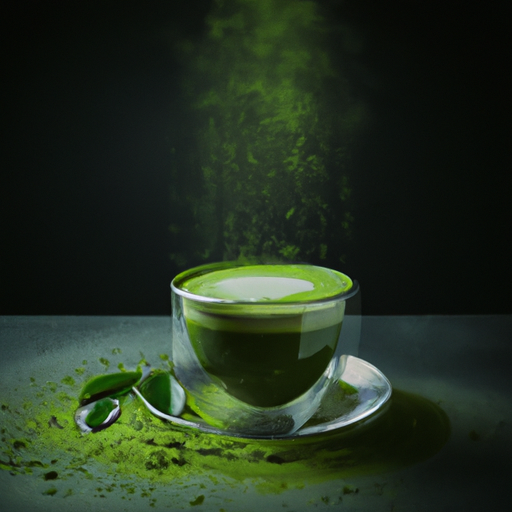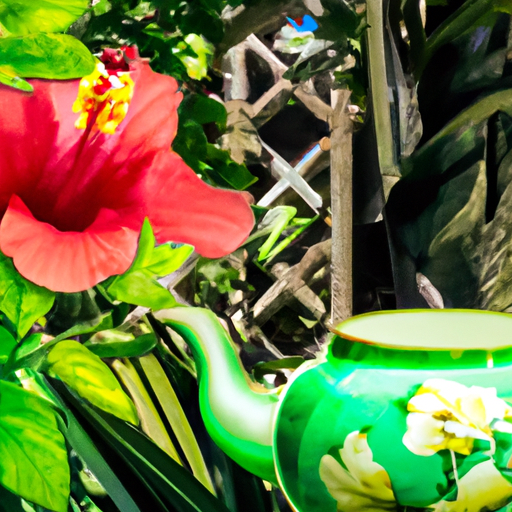The caffeine level in matcha has always piqued my interest. Being a daily green tea drinker, the claims of matcha being a strong energy and concentration booster caught my attention. But, what is the actual caffeine content in matcha? Does it have a higher or lower caffeine content compared to other well-liked caffeinated beverages such as coffee or black tea?
In this article, we’ll explore the world of matcha and its caffeine content. We’ll examine how caffeine is measured in different beverages, compare the amount of caffeine in matcha to other drinks, and discuss whether it’s a good choice for those looking to reduce their caffeine intake.
Let’s dive in and find out just how caffeinated matcha really is.
Key Takeaways
- Matcha contains about 35mg of caffeine per half teaspoon serving size, falling somewhere in between tea and coffee in terms of caffeine content.
- Matcha’s caffeine profile is unique and can provide a sustained energy boost without the jitters or crash commonly associated with other caffeinated beverages.
- Preparation methods have a significant impact on caffeine absorption, and adjusting water temperature and ratio can control the amount of caffeine in a cup of matcha.
- Too much caffeine can have negative effects on the body, and assessing caffeine tolerance can help determine how much matcha to consume without experiencing negative side effects.
What is Matcha?
If you’re not familiar with it, matcha is a finely ground powder made from specially grown green tea leaves. Matcha production involves a meticulous process that includes shading the tea plants for weeks before harvest, steaming and drying the leaves, and then removing the stems and veins to create pure leaf material.
This material is then ground into a fine powder using traditional stone mills. Matcha has been an integral part of Japanese culture for centuries and is often used in ceremonial contexts.
The preparation of matcha involves whisking the powder with hot water until it becomes frothy, creating a thick and rich drink that is served in small portions. Due to its unique flavor profile and cultural significance, matcha has become increasingly popular in Western countries as well.
Understanding caffeine levels in matcha can be tricky due to its complex chemical composition. However, research suggests that matcha contains roughly 35mg of caffeine per half teaspoon serving size. Compared to other caffeinated beverages like coffee or energy drinks, this amount may seem low at first glance but it’s important to note that matcha also contains other compounds like L-Theanine which can affect how your body processes caffeine.
Understanding Caffeine
Understanding caffeine is crucial in determining the effects of certain drinks on the human body. Caffeine is a natural stimulant found in coffee, tea, and chocolate. It works by blocking adenosine, a chemical that signals to our brain that it’s time to rest. As a result, caffeine promotes wakefulness and increases mental alertness.
Caffeine metabolism varies among individuals, which is why some people may feel more energized than others after consuming the same amount of caffeine. The liver breaks down caffeine into smaller molecules before eliminating it from the body. Genetics, age, sex, weight, and medication use can all influence how quickly or slowly someone metabolizes caffeine. Additionally, some people are more sensitive to caffeine’s effects than others due to differences in their brain chemistry.
Measuring caffeine in matcha requires an understanding of its concentration levels compared to other caffeinated beverages like coffee or black tea. Matcha contains about 30 milligrams (mg) of caffeine per half teaspoon serving size. This amount is lower than regular brewed coffee but higher than most teas except for black tea. However, matcha also contains L-theanine, an amino acid that has calming properties and can counteract some of the negative side effects associated with high doses of caffeine such as jitteriness or anxiety.
Measuring Caffeine in Matcha
Measuring the caffeine content in matcha is important because it can help individuals determine how much of this natural stimulant they’re consuming. The amount of caffeine present in matcha depends on various factors, including the quality, origin, and cultivation techniques used to grow it. Generally speaking, matcha contains less caffeine compared to coffee but more than tea.
Caffeine content measurement in matcha varies from batch to batch and therefore requires careful testing by experts. It’s generally accepted that one cup of traditional Japanese matcha contains around 70 milligrams of caffeine per serving. However, this figure may vary depending on a number of factors such as the type and grade of matcha used as well as how it was prepared.
Matcha cultivation techniques can also play a role in determining its caffeine content. For example, shading the tea plants before harvest results in higher levels of L-theanine, which helps balance out the effects of caffeine. As a result, shaded matcha tends to be smoother and less likely to cause jitters or anxiety compared to unshaded varieties.
Knowing the exact amount of caffeine present in your cup of matcha can help you make informed choices about your daily intake without compromising on flavor or quality. Understanding how much caffeine is present in different beverages is essential for making informed decisions about our daily consumption habits.
In comparison to other popular caffeinated beverages like coffee or energy drinks, matcha offers a unique blend of mental clarity and relaxation without any harsh side effects associated with excessive stimulation. By knowing exactly how much caffeine we’re consuming from our favorite beverage choices, we can make healthier choices that support our overall wellbeing while still enjoying delicious flavors!
Comparing Matcha to Other Caffeinated Beverages
When you’re looking for a delicious and healthy alternative to coffee or energy drinks, matcha stands out as a unique option that offers mental clarity and relaxation without any harsh side effects. Matcha has a moderate amount of caffeine, with about 35mg per half teaspoon serving. This is significantly less than the average cup of coffee, which contains around 95mg.
Comparing matcha to other caffeinated beverages, it shows that it falls somewhere in between tea and coffee in terms of caffeine content. Green tea typically contains around 25mg per 8oz cup, while black tea ranges from 40-70mg per cup. Energy drinks can contain up to 300mg of caffeine per serving, making them much more potent than matcha or traditional teas.
While the caffeine content in matcha may not be as high as some other beverages, there are still health implications to consider. For those who are sensitive to caffeine or trying to reduce their intake, matcha may be a better choice than coffee or energy drinks.
Additionally, matcha contains L-theanine, which helps promote relaxation and calmness while also boosting cognitive function. Overall, drinking matcha can provide a balanced boost of energy without the jitters or crashes associated with other caffeinated beverages.
Matcha’s unique combination of caffeine and L-theanine make it an ideal drink for those looking for sustained mental focus throughout the day. It’s also packed with antioxidants and other beneficial nutrients that contribute to overall health and wellbeing.
By choosing matcha over other caffeinated options, you can enjoy all these benefits without sacrificing your health or experiencing negative side effects later on.
The Benefits of Matcha
You’ll love the numerous health benefits that come with regularly drinking matcha, including increased energy, improved mental focus, and a boost to overall wellbeing. Matcha is packed with antioxidants, including the powerful EGCG that helps protect against cancer and other diseases. It also has high levels of amino acids such as L-Theanine which aids in calming the mind and reducing stress.
In addition to its antioxidant properties, matcha is rich in vitamins A and C, potassium, calcium, and iron. Matcha provides a nutritional boost for those seeking to improve their overall health while avoiding processed foods. Drinking matcha can help aid weight loss by boosting metabolism rates as well.
Considering the many health benefits associated with matcha consumption, it’s easy to see why this beverage has become so popular. However, some people may be hesitant to try it due to its caffeine content.
In the next section, we’ll explore whether or not matcha is a good choice for those looking to reduce their caffeine intake.
Is Matcha a Good Choice for Those Looking to Reduce Caffeine Intake?
As someone who loves matcha but also wants to reduce my caffeine intake, I’ve done some research on how matcha’s unique caffeine profile affects the body.
While matcha does contain caffeine, it also has other compounds that can help slow down the absorption of caffeine and provide a more sustained energy boost.
Additionally, there are tips for reducing caffeine intake while still enjoying matcha, such as opting for lower-caffeine varieties or drinking smaller servings.
How matcha’s unique caffeine profile affects the body
Matcha’s caffeine profile is so unique that it can give you a boost of energy without the jitters or crash commonly associated with other caffeinated beverages. This is because matcha contains L-theanine, an amino acid that promotes relaxation and reduces anxiety while increasing mental alertness. The combination of caffeine and L-theanine in matcha creates a state of focused calm, which makes it an ideal choice for those who are looking for a natural source of energy without the side effects.
When it comes to caffeine metabolism, matcha is different from coffee as its caffeine content is released slowly into the bloodstream over several hours. This means that the effects of matcha last longer than coffee, making it a great alternative for sustained energy throughout the day. However, it’s important to note that too much caffeine can still have negative effects on the body, such as disrupting sleep patterns and causing dehydration. Thus, finding balance in one’s intake is key.
Transitioning into the subsequent section about ‘tips for reducing caffeine intake while still enjoying matcha,’ it’s important to remember that moderation is key when consuming any caffeinated beverage. In order to maintain balance in our bodies, we should be mindful of our intake and find ways to enjoy matcha without overdoing it on the caffeine.
Tips for reducing caffeine intake while still enjoying matcha
Looking for ways to enjoy the benefits of matcha while reducing your caffeine intake? Here are some tips to help you enjoy this delicious beverage without worrying about the caffeine content:
-
Try alternatives to matcha: There are plenty of other tea options out there that are naturally lower in caffeine than matcha. Some great choices include white tea, herbal teas, and rooibos.
-
Look for caffeine-free matcha options: If you’re still set on drinking matcha, there are some brands that offer decaf or low-caffeine versions. These can be a great way to enjoy the flavor and health benefits of matcha without getting too much caffeine.
-
Experiment with different ratios: You can also try using less matcha powder per serving or mixing it with other ingredients like almond milk or coconut water. This can dilute the caffeine content and make it easier on your system.
-
Limit consumption: If you’re really sensitive to caffeine, simply limiting how much matcha you drink is another option. Try sticking to just one cup per day or every few days instead of drinking it multiple times a day.
-
Consider timing: Finally, consider when you’re drinking your matcha. Drinking it earlier in the day can help prevent any sleep disturbances caused by the caffeine.
Incorporating these tips into your routine can help you continue enjoying all that matcha has to offer without feeling overwhelmed by its caffeine content.
Now let’s take a closer look at how preparation plays a role in determining how caffeinated your cup of matcha will be.
The Role of Preparation in Caffeine Content
When properly whisked, matcha can pack a punch of caffeine that will wake you up and give you sustained energy throughout the day. However, the amount of caffeine in your cup of matcha largely depends on how it’s prepared.
Preparation methods have a significant impact on caffeine absorption, so it’s important to understand how to prepare your matcha for optimal enjoyment. One factor that affects caffeine content is the quality of matcha used. Higher grades of matcha tend to have more caffeine than lower grades because they contain more tea leaves per serving.
Another way to control the amount of caffeine in your cup is by adjusting the water temperature and ratio. Using hotter water or increasing the amount of powder used can result in higher levels of caffeine. It’s also important to note that different preparation methods can affect caffeine absorption differently.
Traditional preparation involves whisking hot water with matcha powder until it forms a frothy mixture, which allows for maximum extraction and absorption of caffeine. On the other hand, adding cold milk or ice may slow down absorption and reduce the overall potency of the drink. Understanding these factors can help you tailor your preparation method to suit your individual needs and preferences when it comes to managing your daily caffeine intake.
Understanding your own personal tolerance for caffeine is crucial when enjoying matcha regularly. The next section will explore this topic further by providing tips on how to determine your tolerance level and adjust accordingly without sacrificing flavor or enjoyment.
Understanding Your Caffeine Tolerance
As someone who enjoys matcha, it’s important to understand my caffeine tolerance. Assessing my tolerance can help me determine how much matcha I should consume without experiencing negative side effects like jitters or insomnia.
With this knowledge, I can adjust my matcha intake accordingly and continue enjoying this delicious beverage in a way that works best for me.
How to assess your caffeine tolerance
If you’re unsure of your caffeine tolerance, you can gauge it by gradually increasing your intake and monitoring any adverse effects. Here are some steps to help assess your sensitivity:
-
Start with a small amount: Begin with a low dose of matcha, such as half a teaspoon or less, and wait at least an hour before consuming more. If you feel any jitters or nausea during this time, hold off on drinking more.
-
Monitor your reactions: Take note of how you feel after consuming matcha. Do you experience any negative side effects? Are you able to stay focused and alert without feeling anxious or jittery?
-
Find alternatives: If matcha proves to be too stimulating for you, consider switching to decaffeinated tea or herbal infusions that offer similar health benefits without the caffeine.
It’s important to remember that everyone’s caffeine tolerance is different, so what works for one person may not work for another. With some experimentation and patience, however, you’ll soon find the right amount of matcha that works best for you.
In the next section, we’ll explore tips for adjusting your matcha intake based on your tolerance levels.
Tips for adjusting your matcha intake based on your tolerance
Adjusting your intake of matcha can be a simple and effective way to manage caffeine sensitivity. If you’re someone who is easily affected by caffeine, it’s important to pay attention to how much matcha you consume.
One tip for adjusting your intake is to start with a smaller serving size and gradually increase as needed. This will allow you to gauge your tolerance level and make adjustments accordingly.
Another helpful tip is to opt for ceremonial grade matcha instead of culinary grade, as it typically contains less caffeine. Additionally, drinking matcha earlier in the day rather than later can also help mitigate any negative effects on sleep or anxiety levels.
It’s important to remember that everyone’s body reacts differently to caffeine, so it’s essential to listen to your own needs and adjust accordingly until you find the right balance for yourself.
Frequently Asked Questions
What are the traditional Japanese ceremonies associated with drinking matcha?
As someone who’s experienced the beauty of Japanese tea culture firsthand, I can tell you that drinking matcha is not just a beverage, it’s an experience.
Matcha preparation techniques have been passed down for centuries and are steeped in tradition. One of the most famous ceremonies associated with drinking matcha is called Chanoyu, which translates to "hot water for tea."
This ceremony involves carefully preparing and presenting the matcha while paying attention to every detail, from the utensils used to the way each guest receives their cup.
Another common ceremony is called Chakai, which is more casual than Chanoyu but still follows traditional practices. Regardless of which ceremony one experiences, drinking matcha is an opportunity to connect with history and culture while enjoying a delicious and invigorating beverage.
Is matcha suitable for people who suffer from anxiety or insomnia?
As someone who suffers from anxiety and occasional insomnia, I’ve done some research on the effects of matcha on sleep quality.
While matcha does contain caffeine, the amount is generally lower than that found in coffee or black tea. However, individuals with caffeine sensitivity may still experience negative effects such as increased heart rate and difficulty falling asleep.
It’s important to note that other factors such as individual tolerance and timing of consumption can also impact how matcha affects sleep. Ultimately, it’s best to listen to your body and make adjustments accordingly if you find that consuming matcha is impacting your sleep quality.
Can matcha be consumed during pregnancy or while breastfeeding?
Pregnancy considerations and breastfeeding concerns should always be taken seriously when it comes to consuming matcha.
It’s important to note that while matcha does contain caffeine, the amount can vary depending on the source and preparation method.
As a symbol of caution, it’s recommended to limit caffeine intake during pregnancy and while breastfeeding.
The American Pregnancy Association suggests consuming no more than 200mg of caffeine per day, which is equivalent to about one cup of coffee or two cups of tea.
It’s also important to consult with a healthcare professional before making any dietary changes during this time.
Ultimately, being mindful of consumption and seeking guidance from a medical professional will ensure the safest approach for both mother and baby.
What is the difference between ceremonial grade and culinary grade matcha?
When it comes to matcha, there are two main grades: ceremonial and culinary. Ceremonial grade matcha is made from the youngest tea leaves and has a more delicate flavor profile with sweet notes and a smooth finish. It’s also more expensive due to its high quality.
On the other hand, culinary grade matcha is made from older leaves and has a stronger, bitter taste that makes it better suited for cooking or blending into smoothies rather than drinking on its own. While both types of matcha contain caffeine, the amount can vary depending on factors such as growing conditions and preparation method.
Overall, choosing between ceremonial and culinary grade matcha comes down to personal preference and intended use.
How does the quality of matcha affect its caffeine content?
The quality of matcha can affect its caffeine content. This is because the cultivation methods used to produce higher quality matcha result in a higher concentration of amino acids such as L-theanine, which can help to moderate the effects of caffeine.
On the other hand, lower quality matcha may contain less of these beneficial compounds and therefore have a higher caffeine content. It’s important to note that while the type of tea plant used and processing techniques also play a role in determining caffeine levels, overall quality is a key factor in understanding how much caffeine you’re getting from your matcha.
Conclusion
After researching and analyzing the caffeine content in matcha, I can confidently say that it is a moderately caffeinated beverage. While it contains less caffeine than coffee, it still provides a boost of energy and focus. However, the preparation method plays a significant role in determining its caffeine content.
Despite its moderate caffeine levels, matcha offers numerous health benefits such as containing antioxidants and promoting relaxation. It may not be the best choice for those looking to reduce their caffeine intake entirely, but it can still be incorporated into a balanced diet with moderation.
Overall, understanding the caffeine content in matcha allows us to make informed choices about our consumption of this popular beverage. Whether we enjoy it for its taste or its health benefits, knowing how much caffeine we’re consuming can help us maintain balance and wellbeing in our daily lives.










